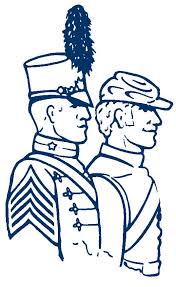Army ROTC at The Citadel celebrates 100 years
Citadel Coastal Artillery Corps ROTC cadets with 8 inch Howitzer M1918 MkVIII, circa 1923
Originally published by The Citadel, October 20, 2016, on thedigitel.com
The Citadel marks its Army ROTC Centennial on Oct. 21, 2016
By Maj. Steve Smith, TAC officer and Citadel historian
The Citadel applied to the U.S. Department of War in 1882, requesting that an Army officer be assigned to the college as Professor of Military Science and Tactics. That application laid the groundwork for what would eventually become an Army ROTC program at the college. (Photo: Citadel CAC ROTC cadets drilling Howitzer M1918 MkVIII, circa 1923)
In the coming years, The Citadel was classified as an Essentially Military College — meaning students were housed in barracks, constantly in uniform, and bound to a disciplinary system. As a result, the war department’s college division inspected The Citadel annually from 1904-27, during which time the college earned the distinguished college title 20 times until the program was suspended. In 1916 and 1917, the designation allowed The Citadel to recommend honor graduates for second lieutenant appointments in the Army. That resulted in in the commissioning of 25 graduates as officers during those years.
As World War I raged in Europe, Congress took action to strengthen the nation’s defense by initiating a training program for reserve and volunteer officers. The Defense Act of June 1916 established the Reserve Officers’ Training Corps, better known today as ROTC. The Citadel along with the Agricultural and Mechanical College of Texas (today’s Texas A&M), Maine University, the University of Arkansas, St. Johns College, and The College of St. Thomas comprised the Army’s original list of colleges designated to establish an ROTC unit.
Related: First Citadel Man Lays Down His Life
When the U.S. entered World War I in April of 1917, the mobilization requirements of the Army made it clear that the ROTC programs alone could not produce the number of officers needed to field an army of two-million men (from its inception in 1916 to 1920, total ROTC production was only 133 officers nationwide). As a result, the war department established a committee on education, as well as training focused on procuring officers from colleges and universities. The purpose was to develop a large body of qualified college men as a military asset, as well as prevent the overall depletion of male students occurring through indiscriminate volunteering. At that point, the ROTC program was suspended and replaced by the Students’ Army Training Corps (SATC). SATC students were inducted into the Army, college regulations were suspended, and the soldier-students became subject to the Articles of War in the service of the country.
On Oct. 1, 1919, simultaneous officer commissioning ceremonies were scheduled at 550 colleges and universities around the country. In Charleston, and the ceremony, which included The Citadel, the College of Charleston, and the Medical College of South Carolina, was scheduled to take place on Marion Square. An outbreak of influenza, however, caused the Army to delay the ceremonies and furlough the Corps of Cadets. When the cadets returned 200 were sworn into the SATC with 125 others entering the basic course of ROTC. They were combined with 60 students from the College of Charleston, and 50 students from the Medical College entering the SATC.
The Armistice ending the war took place just 12 days later, eliminating the need for the SATC which was demobilized by the end of 1918. The war department spent the winter of 1918-19 reconstructing the ROTC system. The ROTC expanded to 240 institutions by 1921. A century after its establishment, The Citadel’s Army ROTC named Palmetto Battalion is, and continues to be, one of the top producing programs in the country.
In its centennial year, 275 colleges and universities have Army ROTC, enrolling 30,000 students annually and producing 70 percent of the officers needed for the Army, National Guard, and Army Reserve.
To learn more about The Citadel ROTC program, please click here.
THE NATIONAL ARMY ROTC PROGRAM TURNED 100 IN MAY OF 2106 – READ THE STORY HERE.
About the author:
 Major Steven V. Smith. Born in El Paso, Texas, Major Smith graduated from The Citadel in 1984 with a BA in Political Science and received a commission as a Field Artillery Officer. He served twenty years in various command and staff positions from battery to Corps level in the active and reserve components. Major Smith joined The Citadel’s Commandant’s Department in August 1998 and is currently serving as the Tactical Officer for the Regimental Band and Pipes. Major Smith has a Masters in American History, is a member of the Society for Military History, the South Carolina Historical Society, and was recently inducted into Phi Alpha Theta, National History Honor Society. Regarded by many on campus as The Citadel’s “unofficial” historian he has written many articles for the school paper, and made presentations to alumni groups on little known or forgotten Citadel history, traditions, and customs. He is currently conducting research for the Centennial History of the Citadel Regimental Band 1909-2009. Major Smith is a founding member of the board of The Citadel Memorial Europe Foundation.
Major Steven V. Smith. Born in El Paso, Texas, Major Smith graduated from The Citadel in 1984 with a BA in Political Science and received a commission as a Field Artillery Officer. He served twenty years in various command and staff positions from battery to Corps level in the active and reserve components. Major Smith joined The Citadel’s Commandant’s Department in August 1998 and is currently serving as the Tactical Officer for the Regimental Band and Pipes. Major Smith has a Masters in American History, is a member of the Society for Military History, the South Carolina Historical Society, and was recently inducted into Phi Alpha Theta, National History Honor Society. Regarded by many on campus as The Citadel’s “unofficial” historian he has written many articles for the school paper, and made presentations to alumni groups on little known or forgotten Citadel history, traditions, and customs. He is currently conducting research for the Centennial History of the Citadel Regimental Band 1909-2009. Major Smith is a founding member of the board of The Citadel Memorial Europe Foundation.

